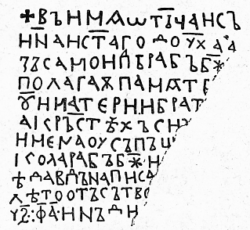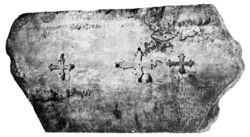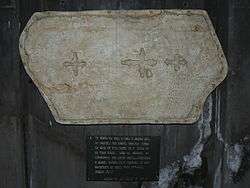Samuil's Inscription
Samuil's Inscription represents the content found on the tombstone of Samuel of Bulgaria's parents, erected in 992/3. This inscription, which was made by the order of Tsar Samuel, mentions the names of his parents and of his brother David.



Currently, the tombstone is stored at the National Archaeological Museum in Sofia, Bulgaria. In 1916, it was transported there from the village of Agios Germanos, near Lake Prespa in Greece. The dimensions of the tombstone are 125–130 cm high, 52–67 cm wide, and 7–10 cm thick. The inscription has been cited by historians such as Fyodor Uspensky, Iordan Ivanov, and Nicholas Adontz.
Inscription
Original text with reconstructed parts in square brackets and modern-style spaces, capital letters and punctuation (hyphens, commas, two dots and a colon) added:
- ✚ Въ имѧ Ѡт︮ь︯ца и Съ-
- и︮н︯а и Ст҃аго Доу︮х︯а, а-
- зъ, Самоипⷧь, рабъ Б︮ж︯[и,]
- полагаѫ памѧть [ѡц]
- ꙋ҃ и матери и брат[оу н-]
- а кръ︮с︯тѣхъ сих[ъ. Се]
- имена оусъпъш[ихъ: Ни-]
- кола рабъ Бж҃и, [Риѱими-]
- ѣ, Давдъ. Написа[но се въ]
- лѣто отъ сътво[рениѣ миро-]
- у ҂ꙅ҃⁖ф҃а҃· инъди[кта ꙅ҃]
The following is the French translation of the inscription by Adontz:
"Au nom du Père et du Fils et du Saint-Esprit, moi, Samuel, serviteur de Dieu, je fais mémoire de mon père, de ma mère et de mon frère sur ces croix. Voici les noms des défunts: Nicolas, serviteur de Dieu; Ripsimé et David. Écrit en l'an de la création 6501, indiction VI."
In English, translated from the French: "In the name of the Father and the Son and the Holy Spirit, I, Samuel, servant of God, made a memory of my father, of my mother and of my brother on these crosses. Here are the names of the deceased: Nikolas, servant of God, Ripsimia and David. Written in the year 6501 since Creation, VI indiction."
The year 6501 since the creation of the world corresponds to 992-993 CE.[1]
Notes
- "Inscription dates 992-993 and Samuel is simply qualified there as servant of God, without any royal title. This cross-checking proves that in 993 Samuel was not still king, this in agreement with Asoghik and Yahya, who put his advent in 997 - 998, after the death of Roman". In: Adontz, Nicolas. Etudes Armeno-Byzantines. Livraria Bertrand. Lisbonne, 1965, Pp. 347-407 (385)
See also
- Comitopuli dynasty
- Bitola Inscription
- History of Bulgaria
- History of the Republic of Macedonia
Literature
- Успенскiй, Ф. И. ( Uspenskiĭ, Fedor I., 1845-1928) Надпис царя Самуила, Известия Русского Археологического Института в Константинополе,1898, III, с. 184 - 194.
- Иванов, Йор. (Ivanov, Ĭor.) Български старини из Македония. София, 1931, с. 25.
- Ivanov, Ĭordan (1872-1947). Bŭlgarski starini na Makedoniia, 1970.
- Кос, М. (Kos, Milko) О натпису цара Самуила, Гласник српског научног друштва 5, 1929, с. 203 - 209.
- Степанос Таронеци-Асохик (Asoghik, Stepanos T., 10th - 11th c.). Всеобщая история Степаноса Таронского - Асохика по прoзванию, писателя ХІ столетия. Перевод с армянскoго и объяснения Н.Эминым. Москва, Типография Лазаревского института восточных языков. 1864. XVIII, 335 стр.
- Asoghik (Stepanos de Taron). L'histoire universelle, Paris, 1859. Translation in German, Leipzig, 1907.
- Stepanos, Tarōnetsi (Stepanos Asoghik Taronetsi, 10th-11th c.) Tiezerakan patmutyun, Erevan, 2000, Pp. 455 (303 - 304).
- Adontz, Nikoghayos. Samuel l'Armenien, Roi des Bulgares. Bruxelles, Palais des academies, 1938, Pp. 63.
- Adontz, Nicolas. Etudes Armeno-Byzantines. Livraria Bertrand. Lisbonne, 1965, pp. 347–407 (384).
- Lang, David M. The Bulgarians, London, 1976.
- Lang, David M. The Armenians. A People in Exile. London, 1981, Pp. 203 (55, 105).